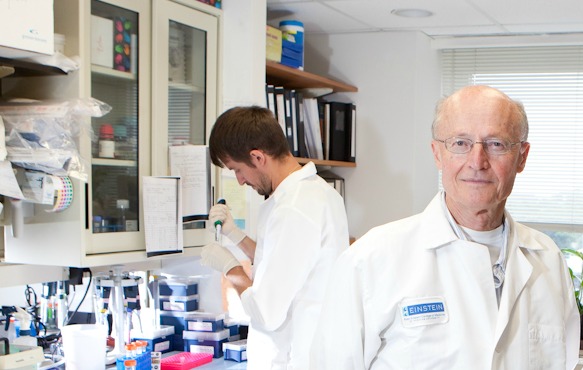
Vern L. Schramm, Ph.D., in his biochemistry lab at Albert Einstein College of Medicine
One thousand dollars per pill?
A single treatment course for hepatitis C virus to cost $83,000?
How can those prices be justified?
The drug-discovery process is a long one, fraught with disappointments and massive investment, no matter what the outcome. Some pharmaceutical companies argue that the high prices charged for their rare “blockbuster” drugs help them recover research and development costs.
While drug pricing and drug access are contentious and controversial issues—ones better addressed by public policy and insurance specialists—I can personally speak to the time-consuming and often heartbreaking path from basic research findings to approved and clinically accepted drugs.
The Long Road from Lab to Pharmacy
The winding path to a blockbuster starts with defining a target. Most target-discovery paths are the job of fundamental researchers at NIH-supported institutions, like those of my Einstein colleagues and thousands of scientists across the country. Understanding viral replication, the ability to sequence viral genomes, the protein structures of viral protein targets has all come from fundamental research funded by American taxpayers through federal support of research universities.
The federal investment can pay off in human health. With the right target, pharmaceutical companies can home in on drug design, knowing the essential nature of their target. But the odds are firmly stacked. There is a 0.1 percent chance that the first drug candidate for a target will ever become a blockbuster, defined as a drug generating annual sales of at least $1 billion.
Today, drug discovery often starts by testing chemical libraries of more than a million compounds to see if one interacts with the target. It’s a long and uncertain process; first discoveries are never suitable for development as drugs.
Chemical refinement to find a powerful inhibitor can take several years. Finally, a powerful inhibitor, the drug candidate, will be found. Chemical libraries of over a million compounds and their associated robotics cost hundreds of millions in investment. Chemistry teams supported by biochemists and biologists refine the discovery and add to the development cost. It has been estimated to cost upward of $100 million to bring one drug candidate to the stage of human testing.
Dizzying Array of Questions and Potential Hurdles
Can the candidate drug be manufactured at reasonable cost? Is it chemically stable? Will it be stable on a pharmacy shelf? Does the candidate have oral availability? Does it last in the circulation long enough to reach the target tissues? How is it metabolized?
And the list of questions for researchers and, later, pharmaceutical companies goes on. . . .
What are the products of metabolism and are they toxic, mutagenic or carcinogenic? Does it have side effects? Preclinical development and phase 1 clinical trials costing additional millions answer these questions, but the answer is discouraging, it is back to the drawing board.
Candidates making it through phase 2 trials must be more effective than current FDA-approved therapy. For drug candidates that are, phase 3 trials must demonstrate effectiveness and low side effects in large numbers of patients at multiple, independent clinical sites, adding hundreds of millions to the cost.
Meantime, from the moment a target is identified and a patent is filed, the legal clock begins ticking. Patent law provides protection from competition for 20 years, but it takes an average of 12 years for a drug to make it to market. That leaves pharmaceutical companies with an average of eight years to recoup costs before their products are sold as generics.
Risk/Reward Once in Phase 3
For candidates eliminated in phase 3, it is not unusual to generate billion-dollar losses. For those that make it to FDA approval, there is a rush to recoup the investment. In the short patent life remaining after a long development period, competitors are racing for the same target. There is only one way to ensure financial success. That’s why we sometimes see $1,000-a-pill pricing.
What is often underappreciated in target discovery and drug development is the critical importance of a partnership between bench science and industry. Academic researchers want to develop a drug. They cannot do it alone. But they play an essential role in target discovery and validation, in experimental chemistry to show the right direction for effective compounds and in developing proof of concept of academic molecules in biological systems. Once these barriers are crossed, the drugs must be convincing enough to persuade industry to risk an average of $1.8 billion in development.
Blockbusters don’t come easily, but when they do they can present a double win: financial reward for pharmaceutical companies—and for patients, therapies that can improve, extend or even save lives.

